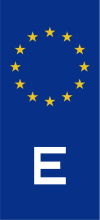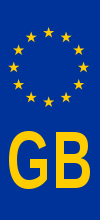Vehicle registration plates of the European Union
Vehicle registration plates of the European Union are the mandatory number plates used to display the registration mark of a vehicle in the respective Member States. Most motor vehicles which are used on public roads are required by law to display them.
Format
The common EU format of having a blue section on the extreme left with EU circle of stars and the country code was introduced by Council Regulation (EC) No 2411/98 of 3 November 1998[1] and entered into force on the 11 November 1998. It was based on a model registration plate which several member states had introduced: Ireland (1991),[2] Portugal (1992) [3] and Germany (1994).[4] Luxembourg plates had displayed the European Flag on the left part since 1988.
The EU format is optional in Finland and the United Kingdom. Denmark implemented the EU format on a voluntary basis in 2009.[5] Vehicles with EU number plates do not need to display the white oval international vehicle registration code while within another member state. However, according to the small print of the French legislation, the specified size of the lettering is slightly larger than that used on UK plates.
Within the United Kingdom, motorists with vehicles registered in Great Britain may use number plates featuring the national flag of England, Scotland and Wales, or alternatively the Union Flag, together with the code name "ENG" for England, "SCO" for Scotland, "Wales" or "CYM" for Wales, "GB" for Great Britain or "UK" for United Kingdom respectively. Although not officially recognised outside the UK, they are authorised by the nation's Driver and Vehicle Licensing Agency.[6] However, motorists with vehicles registered in Northern Ireland fall within the jurisdiction of the Driver & Vehicle Agency, which does not permit the letters NI to appear alongside any flag; only the Union Flag alongside GB/UK or the EU format (featuring in this case the letters GB), being optionally permitted.[7] The British Overseas Territory of Gibraltar, unlike the Crown dependencies of Jersey, Guernsey and the Isle of Man, counts as part of the EU and, therefore, uses number plates in the EU format.
Several non-EU European states have implemented similar formats, replacing the Circle of stars with own symbols. Norway is an example of such state, issuing europlates with the Norwegian flag replacing the Circle of stars. From those states that joined in the 2004 enlargement of the European Union Malta already used europlates, Slovakia had used its coat of arms instead of the Circle of stars, while Hungary, Latvia, Lithuania and Poland had used EU number plates displaying the national flag before their accession, as did Bulgaria and Romania before their accession in 2007. These formats are valid in countries that has signed the Vienna Convention on Road Traffic, as both the EU format and e.g. the Norwegian format satisfies the requirements set in the convention.




























List
Vehicle registration plates of each European Union country are described in the following table:
Motorcycle plates
These are used for motorcycles and vehicles where mounting space is an issue, such as taxis which display their licence plate beside the registration plate, and vehicles imported from countries where the mounting space was not originally designed to take European-sized plates (e.g. USA).
| Member state | Abbr. | Example |
|---|---|---|
| | F |  |
| | D |  |
| | I |  |
| | LV |  |
| | M |  |
| | PL | |
| | E | |
| | S |  |
| | GB | |
See also
References
- ↑ Council Regulation (EC) No 2411/98 of 3 November 1998
- ↑ http://www.irishstatutebook.ie/1990/en/si/0287.html
- ↑ http://www.worldlicenseplates.com/world/EU_PORT.html
- ↑ http://www.worldlicenseplates.com/world/EU_D6XX.html
- ↑ http://www.skat.dk/SKAT.aspx?oId=1815328&vId=0 (dänisch)
- ↑ DVLA (27 April 2009). "INF104: Vehicle registration numbers and number plates" (PDF). Retrieved 2009-09-28.
- ↑ http://www.parliament.uk/Templates/BriefingPapers/Pages/BPPdfDownload.aspx?bp-id=SN01328


